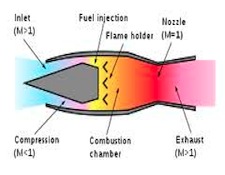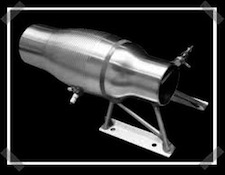It’s the time of year for saving money!

Do you know what a ramjet is? It’s the world’s simplest jet
engine; has no moving parts; and consists of nothing more than a tube with an
internal diameter that starts big, tapers to much smaller, and then quickly
flares to big again. Near the smallest point, there’s a number of tiny holes
that act as spray nozzles for the engine’s fuel, and just after them is a spark
plug or some similar kind of ignition device that fires to get the engine
started.
The way a ramjet works is equally simple: As you push it
through the air (it needs be moving to get started) air is forced into the
front big end and continues down the tube. As the tube gets smaller, the air
flow is forced to speed-up by the progressive restriction. As it passes over
the spray nozzles, Bernoulli effect (pressure is reduced at right angles to the
direction of flow of a gas or liquid) causes fuel to be sucked out of the
nozzles and into the flowing air, forming a fuel-air mixture that is fired,
initially by the spark plug, and then just becomes a continuous flame, as more
and more fuel-air mix enters the second big end (the combustion chamber). The
burning mix is the jet exhaust, which forces the tube (and whatever is attached
to it) to move faster through the air, which forces more air into the tube to
be mixed with more fuel, to be burned, to force the tube ahead even faster.
With a ramjet, the faster you go, the faster you go, and the farther the point
of combustion moves down the (for that reason, long) tube, until, finally, the
engine is moving so fast and shoving so much air through itself that the flame
is finally forced completely out the back end of the tube and the whole process
stops.
A lot of people have been asking lately why High End audio
costs so much, and as a former manufacturer, I’m here to tell you that, from a
pricing standpoint, the High End acts just exactly like a ramjet: The more
expensive stuff gets, the more expensive it has to be, and around and around
and around it goes. The real question is not “will prices go up”, but when or
if they will, like a ramjet, finally “force the flame out the back end of the
tube” and stop the process, entirely.
I wrote, recently, about one High End manufacturer who used a premium
faceplate and handles on a $5,000 amplifier even though those parts cost him
$200 to have made and added a full $1,000 to the amp’s retail price. When
asked, he told me that if he hadn’t used those, but had used simple sheet metal,
instead, and had offered the amp for $4,000 instead of $5,000, he might not
have sold any of those units at all.

It’s true; pricey goods need to LOOK pricey, or people won’t
buy them. And it costs money to get that look or to achieve that standard of
quality, and that raises the price. Once again, it’s “the faster you go, the
faster you go.”
Another issue that works exactly the same way is what
economists call “negative price elasticity of demand”. What that means in plain
language is that the more stuff costs, the less of it you’re going to sell. I
read recently that the new “Anniversary Edition” of the Goldmund Apologue
speaker will be priced at around US$500,000 and will be available only in very
limited quantity. The fact of it is
that, at that kind of pricing, only a very few people can afford them anyway,
so, regardless of any quantity limitation, only a very few of those speakers will
ever be sold.
It’s not just at the extremes of pricing, though, that these
considerations apply. I saw recently that one cable manufacturer is using
carbon-fiber “shells” on his RCA connectors. If those shells – which, trust me
as a former cable manufacturer, are cosmetic, only, and have absolutely no
effect on the cables’ performance – cost the manufacturer US$5 each to buy and
he uses, as he must, four of them for a set of interconnects, then his
additional cost for using them will be US$20 and, at the normal “five up”
multiplier for most manufacturing operations, they will add US$100 to the
retail price of his cables. Same thing for packaging: my cable company paid
more than US$30 each for the hand-crafted, laser-etched wooden presentation
cases for some of our cables. That added better than US$150 to the MSRP of
those products, but when people are being asked to pay more than US$1,000 for
ANYTHING, they want it to look as good as it costs.
So here’s the question: in the last paragraph, you saw that
carbon-fiber shells and deluxe packaging – both things that have nothing at all
to do with anything other than the appearance of the product – can, together,
add more than US$250 to its price. Is it really worth it to you? If you could
buy exactly the same performance for US$250 less, or (in the case of the
faceplate and handles of the amplifier) US$1,000 less, or with the Goldmund
Apologue Anniversary Edition, some number of thousands or tens of thousands of
dollars less money for a “Plain Jane” version, would you?

Every manufacturer of High End audio equipment is constantly
faced with the delicate balancing act of trying, all at once, to make his
products sound great so you’ll want to buy them; to make them pretty enough and
of sufficiently high quality that you’ll be willing to pay the price that must
be charged if he is to stay in business; and to do both of those things at a
low enough overall cost of manufacture and operation that he’ll be able to make
a decent profit.
One basic fact is constantly working against him, though: If
the rent is US$1,000 a month and he’s selling a thousand items a month, his
rent cost per item will only be US$1.00, but if he’s only selling one item per
month, that one item has got to pay for the whole month’s rent. And, all of a
sudden, there’s the ramjet, again: the fewer the sales, the higher the cost per
item; the higher the cost per item, the higher the price of sale has to be; the
higher the price of sale, the better and prettier the item has to be for people
to want it; the better and prettier it has to be, the higher the cost of
manufacture and the necessary retail price will be; the higher the retail
price, the fewer will be sold; and around and around, and around again.
Are half million dollar speakers and proportionally expensive
audio products of all kinds approaching the limit? Will the flame blow right
out the tail pipe and put an end to the whole High End process?
Only time will tell.






Great article & a conundrum. I am a speaker manufacturer and approached a dealer about selling a $3k / pr. speaker I was designing. His reply was, no one came into his shop looking for speakers less than $10k. So, do I jack up my price and tweak the speaker or hold onto my integrity and look for the $3k market? We believe there is a market for an American made, well crafted speaker at $3k and are not going to jump though marketing hoops. There are many small manufacturers that are direct selling amazing products to keep the cost down to the consumer. I loved going to hi-end stores, but the pricing “ramjet” you spoke of led me to DIY or smaller, newer manufacturers or used equipment. Audio shows are now dominating the scene so consumers can hear and see the gear that many dealers won’t carry. It is a great way for consumers to be exposure to all kinds of gear that may never be seen in “hi-end” stores.
I have heard the same story from another manufacturer who made a $2500/pr speaker – dealers couldn’t afford to give it floor space…
I hear a different story where the dealers DEMAND that you floor it.
If I were you I would make sure you sold your speakers direct first and then through other pipelines like audiophile catalogs, direct at regional shows.
Invest your money in creating consumer demand. Buy ads in the top publications. Hire a top PR firm and act like a new player in the space but with a great value proposition to the consumers. This is a recipe for success.
I think I hired Ram Jet to pump my septic system but then again I digress. 🙂
Once again, an insightful article Roger. Thank you for sharing with us.
People won’t pay less for less. They’re likely to shop for used at 50% off, and high end manufacturers are likely to sell fake “used” to tap on that market. A Mercedes-Benz exec once said the entry level in north america is the used car (sold in Canada as “Signature” models).
HigherFi.com is apparently well stocked of super high end products sold at discount. Interestingly, most of these brands are not sold in stores anyway…
Does anyone reading this seriously think a $100,000 speaker system actually sounds $90,000 better than a $10,000 speaker system? And sound is supposed to be what it’s all about with audio, isn’t it?. Audio products reach a point of diminishing returns rather quickly, as far as sound quality vs. price is concerned. The REAL determining price factor any product is what the market will bear, and with audiophiles, that can be very high.
But think about this, most very high end manufacturers only sell a relatively small quantity of product in any given year, so their profit margin must of necessity be MUCH higher than that of a manufacturer who sells really good quality cheaper products in large quantities. Very high end manufacturers often depend on sales of perhaps less than ten units a year to pay their employees, administrative, public relations and advertising costs, executive salaries, and of course, enough net profit to make it worth while to keep the company in business. That really doesn’t leave a whole lot, percentagewise for material and manufacturing costs.
There is a point somewhere in the price hierarchy where the actual dollars spent on material and manufacturing costs for a given product increase very little compared to the increase in retail price. It is around that point where one gets the best bang for the buck, and I’d guess that point is only a small fraction of the price of the highest end audiophile products.
There always will be people with too much money to spend, and the business catering for such customers. Perhaps we should separate these customers from “sane” people, when speculating about the future of Hi-end gear. If it is for “insane” people then there is no conundrum but a conscientious choice of that market segment by the gear selling businessmanufacturer and nothing really matters. If it is for “sane” people, they have dropped out of this vicious price-hike cycle long time ago. Thus, it is a matter of choice of what market segment you are working for.